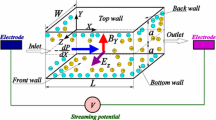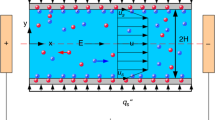Abstract
In numerical studies on microscale electroosmotic flows, the electric double layer (EDL) effect is usually predicted by solving the traditional Navier-Stokes equation subjected to the slip velocity induced by the electric-charged wall as a boundary condition. Recently, Suh and Kang (Physical Review E 77, 2008) presented the asymptotic solutions of the ion transport equations near a polarized electrode under the action of an AC field, and then proposed a new theoretical model of the slip velocity on the electrode considering the ion adsorption effect. In the present paper, we apply the model to a two-dimensional AC-electroosmotic flow in a microchannel to calculate the slip velocity on a pair of coplanar asymmetric electrodes embedded on the bottom wall, and then experimentally measure the slip velocity using the micro-PIV technique to validate the theoretical model. Comparison shows an excellent overall match between the theoretical and experimental results, except for on the narrow electrode at low frequencies. Next, we numerically perform parametric studies regarding the AC frequency, effective Stern-layer thickness and ion adsorption effect to further understand the characteristics of the AC electroosmotic flow. Results show that, as the frequency increases, the slip velocity also increases. In addition, the velocity decreases with increasing either Stern-layer thickness or ion adsorption effect.
Similar content being viewed by others
References
D. Li, Electrokinetics in Microfluidics, Elsevier, London, UK, (2004).
N. G. Green, A. Ramos, A. González, H. Morgan and A Castellanos, Fluid flow induced by nonuniform ac electric fields in electrolytes on microelectrodes. III. Observation of streamlines and numerical simulation, Physical Review E, 66 (2002) 02635 (11 pages).
S. Debesset, C. J. Hayden, C. Dalton, J. C. T. Eijkel and A. Manz, An AC electroosmotic micropump for circular chromatographic applications, Lab Chip, 4 (2004), 396–400.
M. Z. Bazant and Y. Ben, Theoretical prediction of fast 3D AC electro-osmotic pumps, Lab on a Chip, 6 (2006), 1455–1461.
N. Sasaki, T. Kitamori and H. B. Kim, AC electroosmotic micromixer for chemical processing in a microchannel, Lab on a Chip, 6 (2006), 550–554.
S.-H. Huang, S.-K. Wang, H. S. Khoo and F.-G. Tseng, AC electroosmotic generated in-plane microvortices for stationary or continuous fluid mixing, Sensors and Actuators B, 125 (2007), 326–336.
N. Loucaides, A. Ramos and G. E. Georghiou, Novel systems for configurable AC electroosmotic pumping, Microfluidics and Nanofluidics, 3 (2007), 709–714.
J. P. Urbanski, J. A. Levitan, D. N. Burch, T. Thorsen and M. Z. Bazant, The effect of step height on the performance of three-dimensional ac electroosmotic microfluidic pumps, Journal of Colloid and Interface Science, 309 (2007), 332–341.
W. Hibler, B. Weiss, M. Mikolasek, R. Holly, K. Hingerl and B. Jakoby, Particle manipulation using 3-D ac electro-osmotic micropumps, Journal of Micromechanics and Microengineering, 18 (2008), 064016 (6 pages).
H. S. Kwak and E. F. Hasselbrink Jr., Timescales for relaxation to Boltzmann equilibrium in nanopores, Journal of Colloid and Interface Science, 284 (2005), 753–758.
H. M. Park, J. S. Lee and T. W. Kim, Comparison of the Nernst-Planck model and the Poisson-Boltzmann model for electroosmotic flows in microchannels, Journal of Colloid and Interface Science, 315 (2007), 731–739.
S. Kang and Y. K. Suh, Numerical analysis on electroosmotic flows in a microchannel with rectangle-waved surface roughness using the Poisson-Nernst-Planck model, Microfluidics and Nanofluidics, DOI: 10.1007/s10404-008-0321-5 (2008).
J.-B. Zhang, G.-W. He and F. Liu, Electro-osmotic flow and mixing in heterogeneous microchannels, Physical Review E, 73 (2006), 056305 (8 pages).
T. J. Craven, J. M. Rees and W. B. Zimmerman, On slip velocity boundary conditions for electroosmotic flow near sharp corners, Physics of Fluids, 4 (2008), 043603 (14 pages).
S. Dasgupta, A. A. S. Bhagat, M. Horner, I. Papautsky and R. K. Banerjee, Effects of applied electric field and microchannel wetted perimeter on electroosmotic velocity, Microfluidics and Nanofluidics, 5 (2008), 185–192.
R. F. Probstein, Physicochemical hydrodynamics: an introduction, Wiley, New York, USA (2003).
A. González, A. Ramos, N. G. Green, A. Castellanos and H. Morgan, Fluid flow induced by nonuniform ac electric fields in electrolytes on microelectrodes. II. A linear double-layer analysis, Physical Review E, 61 (2000), 4019–4028.
M. R. Bown and C. D. Meinhart, AC electroosmotic flow in a DNA concentrator, Microfluidics and Nanofluidics, 2 (2006), 513–523.
Y. K. Suh and S. Kang, Asymptotic analysis of ion transport in a nonlinear regime around polarized electrodes under ac, Physical Review E, 77 (2008), 031504 (16 pages).
H. S. Heo, S. Kang and Y. K. Suh, An experimental study on the AC electroosmotic flow around a pair of electrodes in a microchannel, Journal of Mechanical Science and Technology, 21 (2007), 2237–2243.
A. Plecis and Y. Chen, Fabrication of microfluidic devices based on glass-PDMS-glass technology, Microelectronic Engineering, 84 (2007), 1265–1269.
J. Santiago, S. Wereley, C. Meinhart, D. Beebe and R. Adrian, A particle image velocimetry system for microfluidics, Experiments in Fluids, 25 (1998), 316–319.
S. Devasenathipathy, J. Santiago, S. Wereley, C. Meinhart and K. Takehara, Particle imaging techniques for microfabricated fluidic systems, Experiments in Fluids, 34 (2003), 504–514.
J. S. Park, C. K. Choi and K. D. Kihm, Temperature measurement for a nanoparticle suspension by detecting the Brownian motion using optical serial sectioning microscopy (OSSM), Measurement Science and Technology, 16 (2005), 1418–1429.
Author information
Authors and Affiliations
Corresponding author
Additional information
This paper was recommended for publication in revised form by Associate Editor Dongshin Shin
Sangmo Kang received a B.S. and M.S. degrees from Seoul National University in 1985 and 1987, respectively, and then had worked for five years in Daewoo Heavy Industries as a field engineer. He also achieved a Ph.D. degree in the field of Mechanical Engineering from the University of Michigan in 1996. Dr. Kang is currently a Professor at the Division of Mechanical Engineering at Dong-A University in Busan, Korea. Dr. Kang’s research interests are in the area of micro- and nanofluidics and turbulent flow combined with the computational fluid dynamics.
Rights and permissions
About this article
Cite this article
Wang, Y., Suh, Y.K. & Kang, S. A study on the slip velocity on a pair of asymmetric electrodes for AC-electroosmosis in a microchannel. J Mech Sci Technol 23, 874–884 (2009). https://doi.org/10.1007/s12206-009-0104-2
Received:
Revised:
Accepted:
Published:
Issue Date:
DOI: https://doi.org/10.1007/s12206-009-0104-2




